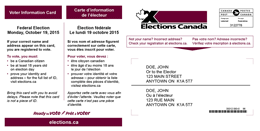How to vote in the federal election

With the October 19th Federal Election just around the corner, it’s a good idea to take a few minutes to plan ahead. A few steps you can take now will make the voting process easier and more efficient.
Register: To vote you must be registered and be a Canadian Citizen and 18 years of age or older the day you vote. To be sure, you can check if you’re registered by going online and using the new e-registration tool at www.elections.ca. Elections Canada can help you with any questions if you go to or call your local Elections Canada office. All 42 BC offices are open 7 days a week. You can also call the national toll-free number 1-800-643-6868.
Location: Just like in real estate, voting in the Federal Election is all about location. Unlike in the BC provincial elections where voters can vote at any polling location, in the Federal Election voters must go to the polling location that has been assigned to them. You will find your poll number and location on your Voter Information Card.
Voter Information Card: Starting this week, millions of personalized Voter Information Cards are being sent to registered voters’ homes including throughout Metro Vancouver and BC. VIC’s identify each voter’s poll number and location for Election Day – Oct 19 and the one for Advanced Polling Days (Thanksgiving long weekend Oct 9 – Oct 12 – open each day from noon to 8 pm). The two locations may not be the same.
When voters receive their VIC, it’s a good idea to check the information. Voters who haven’t received their VIC by October 1st or whose card shows the wrong address should register or update their address online. Or, they can drop by a local Elections Canada office.
To locate your local Elections Canada office you can also use the Voter Information Service tool on the Elections Canada home page at www.elections.ca
Identification: You must have authorized ID to vote. Voters can show a single piece of ID if it is government-issued and has their photo, name and current address like a driver’s license or a provincial ID card. Approximately 86 per cent of Canadians vote using their Driver’s license.
Alternatively, voters can show any two pieces of ID from the list found at elections.ca. Both pieces must have the voter’s name and at least one must also have their current address (e.g. a BC Health Card and phone bill). The list includes many authorized pieces to choose from, from library cards to personal cheques.
No proof of address? Elections Canada knows that some voters don’t have a formal proof of address. That’s why we accept Letters of Confirmation of Residence issued by the administrator of student residences, seniors’ residences, long-term care facilities, shelters, soup kitchens, First Nations’ bands or reserves, or Inuit local authorities.
Voters who live in, or receive services from, one of these places can print the form letter from the Elections Canada website and have it signed by the administrator of the facility. With this letter, and a second piece of ID with their name, they can vote.
As a last resort, voters without a proof of address can show two pieces of ID with their name and ask another voter to take an oath attesting to their address. The person who is attesting must show proof of identity and address and be registered in the same polling division (e.g. a neighbour). This person can attest for only one voter.
Check ahead of time elections.ca the full list of authorized voter ID options and determine which ID you have or must source that meet the criteria.
You can vote today: Using a special blank ballot voters can vote at any Elections Canada office or apply to vote by mail any time up until Oct 13 by 6 pm. The Elections Canada website has special ballot voting details and deadlines or you can ask the Returning Officer at any Elections Canada office to explain.









